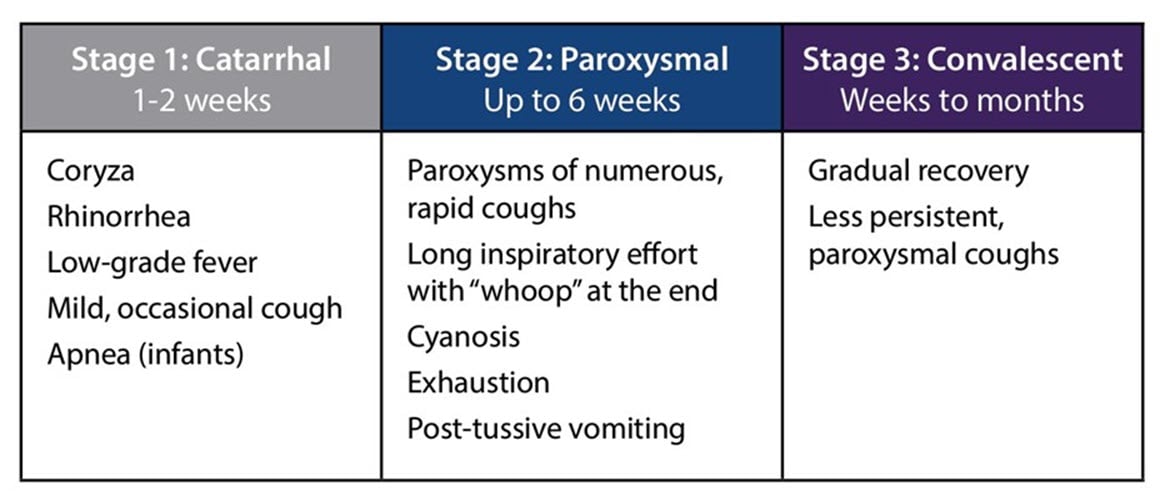Pertussis (whooping cough)
Whooping cough is a respiratory illness caused by the bacterium, Bordetella pertussis. Whooping cough is endemic in the United States. There are peaks in reported cases every few years. The United States is beginning to return to pre-pandemic patterns where more than 10,000 cases are typically reported each year. The CDC provides information on disease surveillance and trends in cases.
Transmission
Pertussis is spread person-to-person through respiratory droplets or contact with airborne droplets. The incubation period is 5-10 days (as long as 21 days) and people are typically contagious from the start of symptoms and for 2-3 weeks after coughing begins.
Credit: Illustrator Meredith Newlove
Signs & symptoms
Pertussis has 3 distinct clinical stages. The second stage is the longest and typically has frequent night-time paroxysmal attacks with an average of 15 per 24 hours, increasing during the first 2 weeks, then stable in number for 2-3 weeks and then gradually decreasing.
Physicians can familiarize themselves with the classic whoop, facilitating prompt clinical diagnosis.
Infants less than one year of age are at highest risk of severe complications, along with those with moderate to severe medically-treated asthma, those with immunocompromising conditions and pregnant people during their third trimester. In infants younger than 12 months of age, about one-third require hospitalization.
Diagnosis
Often the diagnosis is clinical and based on the paroxysmal cough and whoop that is characteristic of pertussis. However, there are three tests available to clinicians. First, a nasopharyngeal culture sent within the first 2 weeks of symptoms is the gold standard, but results take several days. Serology is accurate from 2-8 weeks after cough onset but will not be helpful early in the illness. PCR testing on nasopharyngeal specimens is the most reliable in the first 3 weeks of cough onset and provides rapid results.
Prevention strategies
Vaccination
There are two combination vaccines that include pertussis–DTaP and Tdap (both are a combination of diphtheria, tetanus and acellular pertussis).
CDC recommends routine DTaP vaccination for all infants and children younger than 7 years old. The 5-dose DTaP series, includes 1 dose at each of the following ages: 2 months, 4 months, 6 months, 15 through 18 months, and 4 through 6 years. The CDC recommends a single dose of Tdap at 11 to 12 years of age.
A single dose of Tdap is recommended during every pregnancy, preferably during weeks 27 through 36. CDC also recommends a single dose of Tdap for adults who have never received Tdap.
Treatment
Azithromycin is the antibiotic of choice for pertussis. Secondline therapies include clarithromycin and trimethoprim-sulfamethoxazole. Antibiotics are only effective in the first 1-2 weeks of illness, before the paroxysms start.
Infection prevention & control
Recommended personal protective equipment (PPE) for pertussis is Droplet + Standard precautions. Duration of isolation is until 5 days after initiation of effective antibiotic therapy. In addition, a single patient room is preferred. Consideration should be given to post-exposure prophylaxis for household contacts and health care professionals with prolonged exposure to respiratory secretions.
Adverse events
Reporting
Pertussis is a nationally notifiable condition. Immediately notify state, tribal, local or territorial health departments (24-hour Epi On Call contact list) about any suspected case of pertussis to ensure rapid testing and investigation. States report pertussis cases to CDC.












